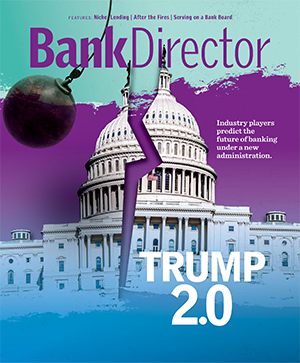Laura Alix is the Director of Research at Bank Director, where she collaborates on strategic research for bank directors and senior executives, including Bank Director’s annual surveys. She also writes for BankDirector.com and edits online video content. Laura is particularly interested in workforce management and retention strategies, environmental, social and governance issues, and fraud. She has previously covered national and regional banks for American Banker and community banks and credit unions for Banker & Tradesman. Based in Boston, she has a bachelor’s degree from the University of Connecticut and a master’s degree from CUNY Brooklyn College.

2024 Bank M&A Survey: On the Hunt for Deposits
Bank leaders’ enthusiasm for M&A appears muted going into 2024, but an appetite for sticky, low cost deposits could motivate some financial institutions to make a deal in the year ahead.
Bank Director’s 2024 Bank M&A Survey, sponsored by Crowe LLP, finds that 35% of bank executives and directors believe they are likely to acquire another institution by the end of 2024, down from 39% in 2023 and 48% in 2022. Eighty-five percent point to an attractive deposit base as a top attribute of an acquisition target in today’s environment, compared with 58% who said as much a year ago. That was followed by a complementary culture (58%), efficiency gains (55%) and locations in growing markets (48%).
Looking over the next five years, more than half (56%) of bank executives and directors say they are open to acquisitions. Almost a quarter plan to be active acquirers.
By and large, respondents do not expect dramatic swings in their bank’s deposit rates over the next 18 months. Forty-five percent expect deposit rates to increase by no more than 50 basis points, and 22% expect them to decline by that amount. If that holds true, that’s positive news for the industry. The Federal Reserve’s Open Market Committee raised the federal funds rate 11 times over the past 18 months, bringing it to a range of 5.25% – 5.50%. “Deposit acquisition [at] reasonable rates will be the key to profitability,” writes the independent director of a private, southwestern bank.
When asked about strategies their bank has employed to generate organic growth in 2022-23, 57% say they’ve added staff in revenue-generating areas. Forty-two percent expanded their product offering within existing business lines, and 38% added new business lines or products. The percentage who have undertaken new digital efforts to attract deposits fell from 50% in last year’s survey to 39% this year.
One respondent points out that digital channels allow customers to move money more quickly, adding, “sticky deposits are not so sticky anymore.”
Organic growth has also been tough to come by lately. Respondents cite economic uncertainty or fear of recession (56%), competition from other financial institutions (55%), and limited or sluggish loan demand (34%) as the top three obstacles to achieving organic growth in the current environment. Nearly a quarter (24%) cite staffing constraints as a growth challenge, a sentiment that was echoed in anonymous comments by survey respondents.
“The inability to attract human capital at all levels of the bank remains our largest concern going forward,” says the CEO of a midwestern bank. “I see this as our biggest obstacle to the survival of community banks going forward.”
Key Findings
Transformational Deals
Forty-one percent of respondents say their bank would be open to a merger of equals, while 34% say it would not be. Nearly a quarter are unsure. Two years ago, almost half (48%) said their bank would be open to such a transaction.
Waning Confidence In Valuations
Respondents cite the pricing expectations of potential targets (71%) as a top barrier to M&A, followed by a lack of suitable targets (59%). Among potential acquirers, 35% would be willing to pay up to 1.5 times tangible book value for the right target. However, just over half of respondents would expect a minimum of 1.75 times book value in a sale. For public banks, 40% feel their bank’s stock is attractive enough to buy an institution that meets its acquisition criteria, a sharp drop from 51% who said as much last year.
Selective Sellers
While a majority (61%) express no preference as to whether a potential acquirer would be a direct competitor, most would rather sell to a regional bank (65%) or community bank (60%) than to a private investor group (18%), multinational bank (12%) or credit union (9%).
Trouble On The Horizon
Forty-three percent anticipate more bank failures over the next 18 months, but among those bank leaders, most do not expect to see more than 10 banks fail. A third of respondents do not anticipate any further bank failures in that time period.
Failed Bank M&A
Three-quarters of bank leaders say they have not discussed the possibility of buying a failed bank, but 17% have discussed it and informed their regulator of their interest.
Sluggish Fintech Investing
A large majority of respondents (79%) say their bank did not invest in or acquire a fintech firm in 2022 or 2023, consistent with last year’s survey results. Of those who did invest in a fintech company, most cite a desire to gain a better understanding of the fintech space.
To view the high-level findings, click here.
Bank Services members can access a deeper exploration of the survey results. Members can click below to view the complete results, broken out by asset category and other relevant attributes. To find out how your bank can gain access to this exclusive report, contact [email protected].
Bank Director will delve deeper into capital, M&A and technology strategies at its biggest event of the year, the Acquire or Be Acquired Conference, Jan. 28-30, 2024, in Phoenix, Arizona.
-
Bank Services Exclusive ResultsSign In To Download


